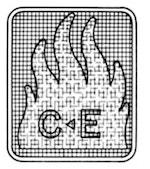Combustion Engineering Corporation Limited

This ™ image was first used in Canada in 1942
The American Stoker Company and the Grieve Grate Company merged in 1912. The name chosen for the new company was Combustion Engineering. Given that their initial product line was boilers and stokers using internal combustion engines this was a well-chosen name.
The company was headquartered in Connecticut. During the 1930s the company concentrated on improving steam engines for locomotives and stayed afloat through the great depression by forming partnerships with other boiler companies, including the Superheater Company.
CE also invested heavily in the naval market when they obtained a contract to supply the US Navy with boilers which set them up to provide boilers for their Liberty fleet during WWII. To ensure their industry dominance they developed a long list of products to be used with and around their boilers including Gunisul, Hilite Insulating Cement and Calcrete Insulating Cements. Developing and distributing pipe insulation products was the significant negligent act of CE as those products were handled by steamfitters, insulators and other workers in a friable state when CE was aware that breathing in asbestos dust was potentially fatal.
Combustion Engineering in Canada
In 1942 when they registered their trademark in Canada their business line was listed as “Steam generating boilers, boiler furnace waterwalls, fuel stokers, air preheaters, economizers, material drying units, and chemical recovery units.” The Canadian Headquarters was in the Dominion Square building in Montreal, Quebec. The also had manufacturing facilities in Cornwall and Brampton, Ontario.
CE provided steam generators and boilers to many industries starting in the 1930s including power plants, ship builders and pulp mills. Until the 1970s CE primarily designed and built boiler assemblies for oil and coal conventional power generation.
In 1985 there were 132 CE steam boilers capable of generating at least 500kW of electrical power installed in Canada. There is no way of knowing how many smaller units existed as there were no statistics kept for this information.

In 1970 the ™ Logo was updated
CE moved into the nuclear power generating market in fierce competition with Westinghouse and General Electric. A better designed computer system gave them a 10% edge over their rivals that helped them to sell nuclear power steam supply systems. They offered a nuclear reactor operator training simulator at their Windsor Connecticut training facility. Canada does not appear to have embraced CE nuclear power steam generating systems as we can find no record of any CE equipment in the 1985 power statistics.
If you worked on ships that were built in North America chances are high that there was a CE Boiler on board. The Combustion Engineering trust has a published list of over 3800 ships that are confirmed to have CE boilers on board.
Land based boilers were installed in hundreds of Canadian locations including, STELCO, Imperial Oil, Bathurst Power & Paper and the Lakeview Generating Station.
ABB purchase of CE
The Company was purchased by multi-national ABB (Asea Brown Boveri) in 1990. This deal looked good on paper as ABB sold primarily in Europe while Combustion Engineering sold to the North American market. Combustion Engineering made steam boilers which were often installed with ABB made turbine generators.
ABB paid $1.6 Billion for CE, an extraordinarily high price considering they also assumed CE’s liability for asbestos products. ABB paid over $900 million dollars to settle asbestos claims against Combustion Engineering between 1990 and 2002 and still they faced over 110,000 asbestos injury claims.
To avoid bankrupting the entire company that employed 28,000 in North America and a further 200,000 worldwide, ABB commenced negotiations with lawyers for the massive group of Plaintiffs. A plan was proposed that ABB would establish a compensation trust to handle all pending and future claims with funding in the amount of $1.43 Billion. The plan was put to a vote and passed by an overwhelming 99%.
Combustion Engineering applied to the bankruptcy court for Chapter 11 protection in February 2003 and this pre-petition agreement was ratified by the bankruptcy court in 2006. ABB borrowed $1.5 Billion to fund the trust and saved the rest of the organization.
CE had a large Canadian presence with several manufacturing facilities in Quebec and Ontario while their oil and gas division was based in Alberta. Negotiations at the time of the organization of the CE trust ensured that Canadians have the same right to compensation from the trust as American claimants.
If you believe exposure to CE boilers, generators or insulation products contributed to your asbestos disease contact Brown Law for information about claiming compensation from the CE Trust.








